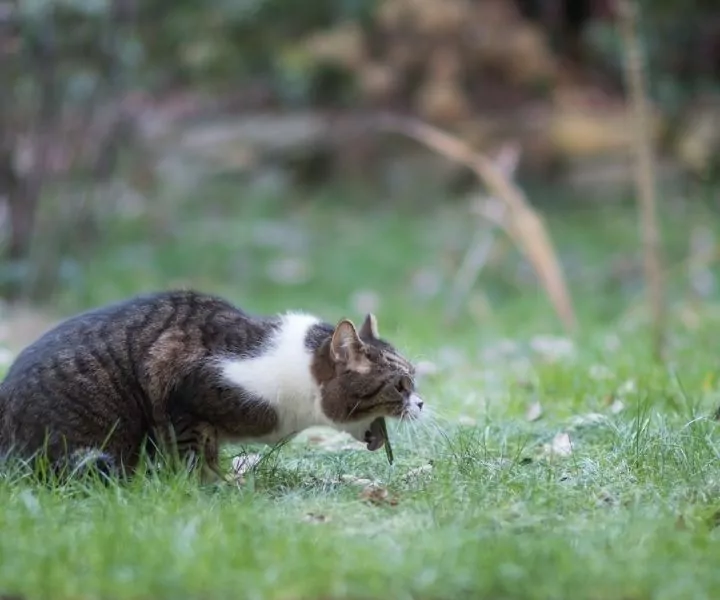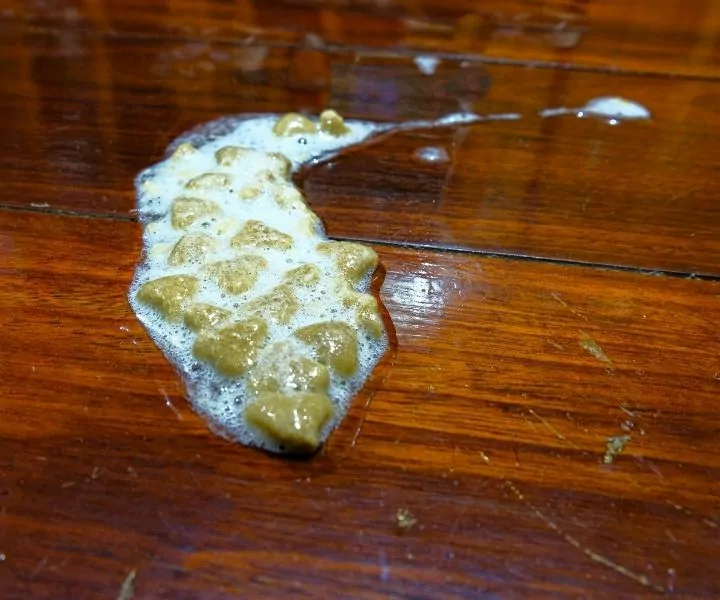Why Do Cats Throw up?
The sound of a cat about to vomit has been named the greatest alarm clock of all time, and it often leads to the question, “Why is my cat throwing up?”. Vomiting is the act of physically ejecting the contents of the stomach and proximal small intestines. The reasons for vomiting can be numerous and can sometimes also be confused with regurgitation.

Regurgitation is the passive act of ejecting esophageal contents through the mouth and is not as vocal or as forceful as vomiting.
Signs and Symptoms of Vomiting – Take Your Cat to the Vet!
There is a long list of signs or symptoms that your cat will display if they are vomiting or nauseous. Listed below is what you can look out for if you find vomit in your home often and if you suspect it is your cat:
- Lethargy or depression
- Decreased appetite
- Hypersalivation
- Painful abdomen
- Weight loss
- Behavior change – hiding or seeking more attention.
- A distinctive sound like crying out just before they vomit includes a short succession of “meows” and then a loud high pitched groan followed by vomit.
If your cat is vomiting, the key factors to note when you see or find vomit include:
- The frequency of vomiting in a specific time frame, for example, in an hour, a week, or a month.
- The color of the vomit.
- The consistency of the vomit – is it watery or more like porridge.
- The contents of the vomit.
- Make a concerted effort to monitor your cat’s general health and behavior to help determine if there are other symptoms as well.
- Monitor litter box habits for signs of increased urination or diarrhea.
Questions Your Vet Will Ask You if Your Cat is Puking
To determine the possible cause of your pet’s vomiting, a veterinarian will inquire about several different factors in your cat’s daily life. Be sure to have the answers at hand to help your vet get to the root of the problem. Some of those questions may include:

- Has anything recently changed in your cat’s diet – a new food or a new pet that has a different food or new snacks or treats that could have been introduced?
- Is your cat on any current medication, or have you used any recently purchased over-the-counter remedies on your cat?
- What is the frequency and type of treats your cat is receiving?
- Are any other pets also vomiting, and can you clearly identify which pet is vomiting?
- Does your cat spend most of its time indoors or outdoors?
- How frequently does your cat vomit, and can you describe how the vomit looks?
- Has your pet’s appetite decreased or increased after vomiting?
- Have you noticed any other abnormalities or gastrointestinal upsets like diarrhea or weight loss?
- When did you first notice your cat vomiting?
Types of Cat Vomit Explained
The appearance of vomit can be grouped in a few categories that could help to explain why your cat is throwing up and if it should be a serious concern.
A cat vomit color chart and reference guide for why your cat is throwing up is a helpful tool to advise on the appropriate action to take for your cat.
| Vomit content or Color | Explanation | Action |
| Worms | High gastrointestinal parasites burdens are very detrimental to your cat’s health. For example, the most common type of worms found in cat vomit is roundworms. | If your cat’s vomit contains visible worms, it is very important to bring this to your vet’s attention as they need to be treated appropriately. |
| Chewed or partially digested food | A cat with a blockage obscures food’s passage through the stomach into the small intestines will vomit due to outflow obstruction. Food allergies and irritating substances will also cause acute vomiting. | Your pet will need to see the vet for possible x-rays, barium study, ultrasound, or a food allergy trial. |
| Hairballs | Cats can occasionally vomit hairballs if they are a long-haired breed or if they over-groom. If your cat has many hairballs and patches of hair loss, it is essential to mention this to your vet. | You can get over-the-counter hairball medication, or you can alter their diet to a hairball diet. |
| Yellow, orange, or brown | Possibly due to partially digested food and bile. | If the vomiting is more than once-off, you need to consult your vet to find the cause of nausea. |
| Red or Pink | May indicate the presence of blood. Blood can be due to stomach ulcers or rodenticide toxicity. | Your vet should be consulted, and a photo of the vomit would be very helpful to help identify digested or fresh blood. |
| Clear or white | A high load of saliva or mucus from the esophagus indicates vomiting on an empty stomach. | If the vomiting is more than once-off, you need to consult your vet to find the cause of nausea. |
| Green | This usually indicates that the food content was brought up from the small intestines. The mixture of the vomitus with bile can turn it green. | If the vomiting is more than once-off, you need to consult your vet to find the cause of nausea. |
| Black or dark brown | Granular brown or black material can be an indicator of bleeding in the gastrointestinal tract. | Veterinary attention is required as soon as possible. |
10 Causes of Vomiting in Cats and What to do About Them
Due to the vast array of reasons a cat may be vomiting – it is essential to find the exact cause to ensure the correct action is taken.
- Toxin ingestion
Toxins can cause vomiting and will generally be sudden in onset. Toxins that can cause vomiting are Easter Lilies, antifreeze (ethylene glycol), pesticides, or chocolate.
In the case of any suspected toxin ingestion, it is best to consult your veterinarian as soon as possible.
- Infectious origin
Viral or bacterial pathogens in the environment or food can cause gastrointestinal upsets. If your cat vomits for more than three hours, it is best to seek medical attention for medication and avoid dehydration.
- Diet
If you have recently changed your cat’s food without gradually introducing it, it may lead to dietary intolerance, possibly due to food allergies. If this occurs, stop the new food, go back to the original food, and discuss a diet change with a vet or nutritionist.
- Gastric origin
The stomach can become irritated by foreign bodies, ulcers, inflammation, and this may lead to vomiting. Therefore, it is imperative to seek medical attention as they can progress to serious medical emergencies if left unattended.
- Intestinal Origin
If the vomiting is due to an intestinal issue, the problem may be due to a foreign body, acute inflammation, inflammatory bowel disease, cancer, or constipation. It is best to discuss these cases with a vet as it will require a battery of tests to determine the exact cause of the vomiting, especially if it has been a chronic condition.
- Organ dysfunction
Kidney insufficiency, pancreatitis as well as liver disease can cause vomiting, and blood tests, as well as a complete clinical exam and history, will be required to diagnose a systemic disease, so consult our vet if you notice increased water intake, concurrent diarrhea, weight loss or pale or yellow gums.
- Vestibular dysfunction
Middle ear infections, neurological diseases involving the vestibular system, or cancer can cause vomiting and is very distressing for a pet, so medical attention as soon as possible is critical.
- Endocrine disease
Severe conditions such as Hyperthyroidism (overactive thyroid gland), elevated calcium (possibly due to cancer), or diabetic ketoacidosis can also have vomiting as a symptom, but weight loss, increased water intake and urination are also present.
- Cancer
Cancer can occur in young or old cats, and if your cat has a poor appetite, chronic vomiting, weight loss, and poor coat condition, it is best to seek medical attention as soon as possible.
- Medication
Check if your cat is on any medications with side effects that include vomiting – some medications like anti-inflammatories or antibiotics can irritate the gastric lining and should rather be stopped, and your prescribing veterinarian should be consulted. Also, ensure that you are administering the medication correctly with or without food.
How Can I Help My Cat if He is Throwing up Undigested Food?
Should your cat be throwing up undigested food, it could be because he is eating too fast or too much at a time. A great way to slow your cat down is with food puzzles or slow feeder bowls. You can also try to feed smaller amounts more frequently.
Chronic regurgitation of undigested food may need to be addressed by a veterinarian.
Treating Cat Vomit at Home
A vomiting cat can become dehydrated very quickly, so it is best not to try and use home remedies first because most over-the-counter medication is not suitable or easily administered to a nauseous cat. Also, human anti-emetics are not appropriate for cats; rather, consult your vet for medication.
If the cause is simply due to hairballs, you can consider over-the-counter hairball treatments, pastes, or even a hairball diet. However, a new diet needs to be introduced gradually to avoid upsetting the GI tract.
Preventing Your Cat From Throwing Up
Taking a few extra precautions to prevent your cat from throwing up can ensure its digestive system stays healthy.
- Ensure you are feeding your cat a healthy balanced diet from a reputable supplier.
- Try not to feed too many treats or table scraps.
- Take note of any foreign material chewed up or missing items that your cat may have had access to.
- Do not allow your cat to chew non-food items like strings, house plants (especially lilies), or yarn.
- If you notice your cat over-grooming or shedding, prophylactically add an OTC hairball treatment before they start vomiting. This is especially important in long-haired cats during the change of seasons.
- If your cat has a sensitive digestive system, be sure to stick to a prescription diet as per your vet’s recommendation.
Cat Vomit vs. Foam
Cat vomit is more often than not interpreted as undigested food, but sometimes they can vomit out white foam as well. This is more indicative of an empty digestive tract but can also be misinterpreted as vomit. Foam can also be produced in the respiratory tract, so it is crucial to monitor your cat and try to see if the vomiting is preceded by coughing or not.

If your cat is vomiting, the best course of action is to confine them to a small area for observation to determine the frequency and content of the vomit. If they continue to vomit, the best course of action is to take them to the veterinarian for medical treatment.
